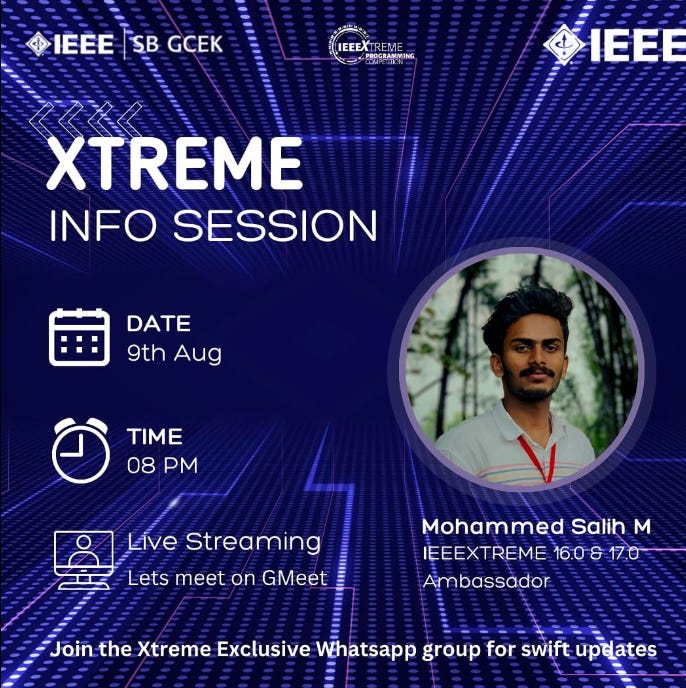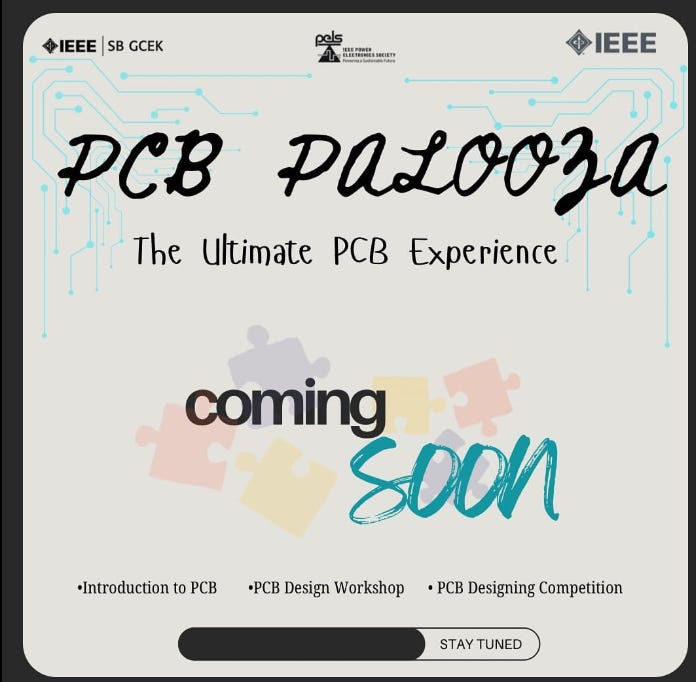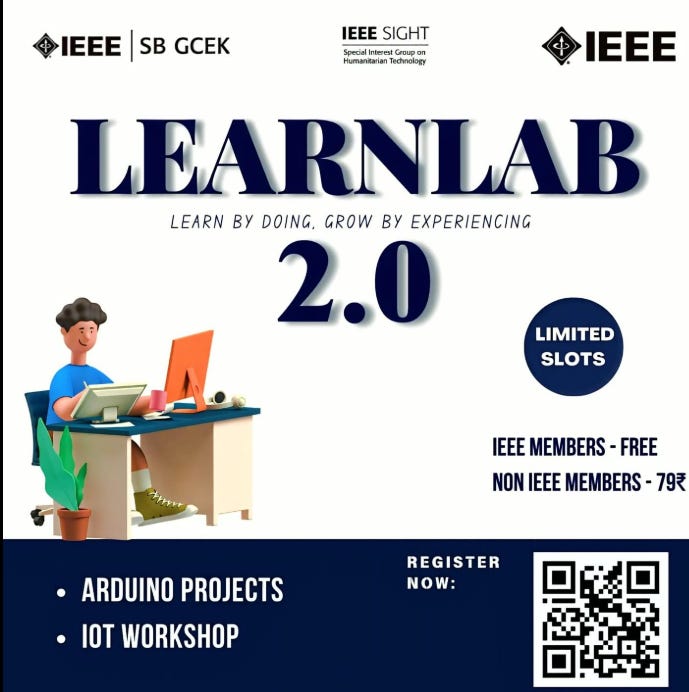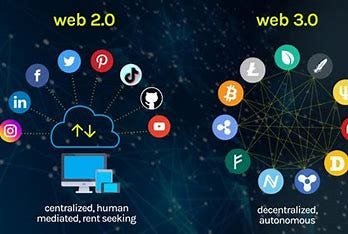Tidings September '24
Bringing you a quick respite from your highly tedious college schedule, and providing you up to date info from around the college and IEEE, through the months of August and September!!!!
What's Cooking 🍲👨🍳
A quick summary into the various activities hosted by the SB, SBCs and the affinity groups through the months of August and September.
#INTRODUCTION TO AI/ML
An interactive talk session titled "Introduction to AI/ML" was held on August 4th, 2024, hosted by IEEE SB GCEK and conducted by Ms. Rini Sara Markose, Treasurer at IEEE LINK. The session, held via Google Meet, saw 85 participants, including 3 non-IEEE members.
Ms. Markose began with a brief self-introduction and spent an hour discussing key areas of interest in AI and ML, highlighting the dynamic nature of the field and the frequent changes in industry trends. She emphasized the future impact of AI and ML across various technological domains, focusing on improved efficiency, reduced human reliance, and minimized errors.
#XTREME INFO SESSION
On August 9th at 8 PM, we had a fun and informative session led by Mr. Mohammed Salih M, an ambassador for IEEE Xtreme 16.0 and 17.0. It was held on Google Meet and aimed to clear up any confusion about "Xtreme 18.0." Mr. Salih shared his insights, experiences, and tips on participating in this exciting competition. Participants got the chance to ask questions and join a dedicated WhatsApp group for more updates.
#LUMINIS QUIZ
On August 6th, 2024, IEEE SB GCEK and Calypso GCEK hosted the Luminis Space Quiz for National Space Week. Mr. Junaid Abdul Nasar led the quiz with 110 enthusiastic participants. The event featured two rounds, with the top 5 teams advancing. Winners received cash prizes and ISRO certificates.
Top teams:
Sanchith KT and Geethika (Govt Brennen College)
Alphy V Nath and Pranav (GCEK)
Vijay Krishna and Devapriya (GCEK)
#Green Hydrogen Technologies and Opportunities
On August 13th, 2024, IEEE SB GCEK hosted a talk on "Green Hydrogen – Technologies and Opportunities." The session was led by Mr. Sivaramakrishnan Ganesha Iyer from Quantech Energy Solutions and Services. Held at the Placement Hall from 10 AM to 12 PM, it was attended by 7th Semester Electrical and Electronics Engineering students and faculty, including Dr. Baburaj and Prof. Shaheen.
Mr. Iyer discussed various aspects of Green Hydrogen Technologies and the future of the industry, highlighting career prospects for Electrical Engineering students.
#Semiconductor Research
On August 15th, 2024, IEEE SB GCEK hosted an interactive talk on "Semiconductor Research," led by Mr. Rohith Soman, a Postdoctoral Researcher at Stanford University. Conducted via Google Meet, the session saw 65 participants, including 18 non-IEEE members.
Mr. Soman introduced himself and discussed key areas in Semiconductor Research, emphasizing the rapidly changing industry trends. He explained the subdomains of particular interest, the reliance of emerging technologies like quantum computing and blockchain on powerful processors, and future opportunities in the field.
#75 Years of Transistors
On August 16th, 2024, IEEE SB GCEK celebrated 75 Years of Transistors with a talk by Dr. Sajesh Kumar, Associate Professor at the Department of Electronics and Communication Engineering, Kannur. The session was attended by 40 students.
Dr. Kumar provided a comprehensive timeline of Electronics Engineering since the invention of the transistor in 1947. The session highlighted the significant contributions and advancements in the digital world due to transistors. He began with an overview of technological advancements in the pre-Transistor era, followed by the need, advantages, and further advancements in transistors.
#National Space Day Celebrations
On August 19th, 2024, IEEE SB GCEK hosted an interactive talk session for National Space Day, led by Mr. Anurag S from AASTRO Kerala. Held via Google Meet, the session was attended by 29 participants, including 9 non-IEEE members.
Mr. Anurag introduced himself and discussed general space knowledge and the Indian Space Programme. He highlighted ISRO's contributions to space exploration and took participants through a timeline of the Indian Space Program's milestones. The session was interactive and thought-provoking, with engaging discussions.
#IOT Workshop
IEEE SIGHT GCEK conducted a SPAx-funded IoT workshop for 12th-grade CS students of GVHSS Kurumathur. The workshop provided hands-on experience with IoT applications, aiming to bridge the gap between academics and industry and inspire students about the exciting possibilities of IoT in the real world. Understanding IoT is essential in this era of connected devices, and this workshop equipped students with the skills to navigate and lead in a tech-driven world.
#Pels Whiz
IEEE PELS SBC GCEK launched an exciting online quiz competition series, PELS Whiz, on August 4th, 2024. Held every Sunday at 7 PM, the event aimed to test participants' knowledge across various domains while fostering healthy competition. Each week, a new thought-provoking question was revealed, allowing quizzers from diverse locations to compete and showcase their expertise.
The series engaged participants over multiple weeks, combining fun with learning and promoting intellectual curiosity and collaboration among students and enthusiasts. PELS Whiz proved to be a unique initiative, demonstrating the potential of interactive activities in building a strong and vibrant community.
#PCB Palooza
IEEE PELS SBC GCEK organized PCB Palooza, an event focused on Printed Circuit Boards (PCBs). The event featured a talk session, a hands-on workshop, and a competition, providing participants with a comprehensive understanding of PCB design and applications.
The talk session covered the fundamentals of PCBs and their role in modern devices. The workshop offered practical experience in designing and assembling PCBs. The event concluded with a competition where participants applied their knowledge to real-world challenges.
PCB Palooza encouraged learning, creativity, and problem-solving, making it a successful and enriching initiative.
#Ab Initio Snapspeak winner
Congratulations to Muhammad Rashad from S3 CSE for winning the
“ SNAPSPEAK: An extempore competition*” conducted as part of AB INITIO 4.0 , organized by IEEE SBC GCEK.🖍️
#Ab Initio Spelling Bee winner
Congratulations to Yashin P K from S3 EC-B for winning the
“ SPELLING BEE” conducted as part of AB INITIO 4.0 , organized by IEEE SBC GCEK⭐
#C++ Workshop
On 28th August, the Computer Society of IEEE SB GCEK hosted a C++ Workshop as the first pre-event for the IEEE Xtreme coding competition. Led by Jeevan Babu (S7 CSE), the online session started at 8:00 PM. Participants gained essential C++ skills, preparing them for the competition. The workshop was interactive, with active participation from attendees.
#Evolve 2.0 Jam Competition Winners
IEEE PELS SBC GCEK recently held the third event in the EVOLVE 2.0 series, the Voice Of Views: Just A Minute (JAM) Competition.
The winners were: 🏆 1st Place: Govind K A & Aiswarya K 🥈 2nd Place: Yadunand Arun & Deeshnav K 🥉 3rd Place: Alaka P & Muhammed Aman S P 🥉 3rd Place: Swathika S & Dhanupriya K
Congratulations to the winners and all participants for their outstanding performances!
#Pixelflow
On September 10th, 2024, IEEE SB GCEK conducted an engaging talk session on Figma and related tools, led by Shereen Rafi (S7 CSE, GCEK). The session provided a comprehensive walkthrough of Figma tools, offering a tutorial on their usage and covering the software's technical aspects.
The highly interactive session saw participants actively asking questions about various aspects of Figma. Notably, many participants were Polytechnic College students, drawn to the session due to their creative interests.
#LearnLab Mentors call
IEEE SIGHT GCEK is excited to relaunch LearnLab 2.0, a peer-to-peer learning program empowering students to work on innovative Arduino projects. The program seeks dedicated mentors to guide participants, offering training if needed. Basic knowledge of Arduino projects is sufficient.
Mentors will share their knowledge and experience, guide participants in overcoming challenges, inspire and motivate students, and be part of a community shaping the future of technology and innovation. Passionate about mentoring? Apply now to become a LearnLab 2.0 mentor at LearnLab Reloaded. Let's empower the next generation of innovators together!
#Onam Poster Making Competition
IEEE CS SBC GCEK recently held a Happy Onam poster design competition, inviting art enthusiasts to showcase their creativity. Participants were tasked with designing posters that captured the joy and magic of Onam.
The competition saw vibrant and imaginative entries from participants, including many Polytechnic College students, who used this opportunity to express their artistic talents. The winning poster, which beautifully depicted Onam's radiance and charm, was selected and featured on our social media handles.
The event successfully celebrated the festive spirit of Onam and demonstrated the participants' enthusiasm and artistic skills.
#Code-a-thon Mentor call
The Computer Society of IEEE SB GCEK recently announced a series of upcoming coding events and invited knowledgeable and passionate mentors to share their expertise with eager learners. The events, which will be conducted online, require mentors with basic knowledge in any programming language.
Certificates worth activity points will be provided, and the opportunity is open to both IEEE and Non-IEEE members. The registration deadline for mentors is 17th September. Interested individuals can register at the provided link: Coding Mentors.
#Revelio Monthly Quiz
The Computer Society of IEEE SB GCEK recently held Quiz #1 of the monthly quiz series, Revelio, on the topic of Cybersecurity. The event took place on Thursday, 19th September 2024, at 7:30 PM on the Quizziz platform.
Participants registered by 18th September, with IEEE members enjoying free registration, while non-IEEE members paid a fee of Rs. 20. The quiz tested participants' technological knowledge and provided an engaging and educational experience.
#Metrica Membership Development Session
On 20th September 2024, IEEE IAS SBC GCEK, in collaboration with IAS SBC VJEC and IAS SBC GECKKD, hosted an insightful membership development session, METRICA, as part of LA GUERRE. The event was organized by IEEE IA/IE/PELS Jt. Chapter Kerala and aimed to unlock the potential of participants with IEEE Societies—IAS, IES, and PELS.
The session took place on Google Meet at 7:30 PM and attracted enthusiastic participation. Attendees gained valuable insights into the benefits of IEEE membership and how to enhance their IEEE journey.
#Code-a-thon Learners Call
The Computer Society of IEEE SB GCEK recently launched Code-A-Thon, a series of coding events focused on developing skills in Python, Flutter, Web development, and more. The initiative required no prior knowledge, only an enthusiastic mindset to learn and grow.
Participants registered online at this link, with the events being conducted in an online mode. Certificates were provided for active participation. The opportunity was free for both IEEE and Non-IEEE members, but seats were limited to 100.
Code-A-Thon provided an excellent platform for participants to upgrade their skills and knowledge in various programming languages and technologies.
#LearnLab Learners Call
IEEE SIGHT GCEK recently launched LearnLab 2.0, featuring Arduino and IoT workshops. The event offered hands-on learning, peer-to-peer interaction, and expert mentorship. Participants received certificates and collaborated in groups. Registration was free for IEEE members and ₹79 for Non-IEEE members. The workshops were a great success, empowering students with practical skills.
#PCB Palooza
On September 28th, 2024, IEEE PELS SBC GCEK and IA/IE/PELS Jt. Chapter Kerala held a hands-on PCB design workshop using KiCad at the EEE Software Lab. Participants gained practical experience, networked, and received certificates. The event successfully enhanced PCB design skills.
Catch the Drift🌬
Hydrogen Fuel Cell Vehicles: The Future of Clean Transportation
As the world moves toward sustainable energy solutions, hydrogen fuel cell vehicles (FCVs) are gaining attention as a viable alternative to fossil-fuel-powered and battery-electric vehicles. Unlike traditional electric vehicles (EVs), which store energy in large lithium-ion batteries, FCVs generate electricity on demand using hydrogen and oxygen, producing only water vapor as a byproduct. This technology has been around for decades, but recent advancements are pushing it to the forefront of the automotive and transportation industries.
One of the most significant breakthroughs in hydrogen mobility is the development of efficient hydrogen storage and distribution systems. Storing hydrogen in a compact, safe, and cost-effective manner has long been a challenge. However, new methods like solid-state hydrogen storage and liquid organic hydrogen carriers (LOHCs) are making it easier to transport and refuel FCVs efficiently. Companies like Toyota and BMW are investing heavily in improving storage technology, allowing hydrogen-powered cars to achieve longer driving ranges with shorter refueling times.
Another major advancement is in fuel cell efficiency. Traditional fuel cells were bulky, expensive, and had limited lifespans. However, with proton-exchange membrane (PEM) technology, modern fuel cells are becoming smaller, more powerful, and more durable. These improvements mean that FCVs can now compete with battery-powered EVs in terms of performance, making them more attractive to consumers and fleet operators.
Perhaps the most crucial shift in the hydrogen industry is the rise of green hydrogen production. Historically, most hydrogen has been produced from natural gas, making it less environmentally friendly. But with electrolysis powered by renewable energy, green hydrogen is emerging as a truly zero-emission fuel. Companies like Plug Power and Nikola Motors are working on building hydrogen ecosystems where solar and wind energy power hydrogen production, making FCVs a more sustainable option.
While battery EVs dominate passenger car markets, hydrogen fuel cells are proving to be the preferred choice for heavy-duty transportation. Trucks, buses, trains, and even aircraft require long ranges and fast refueling times—areas where battery technology struggles. Major manufacturers like Daimler, Volvo, and Hyundai are investing in hydrogen-powered freight trucks, and experimental hydrogen-powered airplanes are already in development. This shift could revolutionize industries that rely on long-haul transport, reducing carbon emissions on a massive scale.
A major challenge slowing FCV adoption is the lack of hydrogen refueling infrastructure. Unlike charging stations for EVs, hydrogen refueling stations are expensive and require specialized facilities. However, governments and private enterprises are now ramping up investment in hydrogen networks, with Japan, South Korea, and Germany leading the way. New innovations, such as mobile hydrogen refueling stations and on-site hydrogen production, could make hydrogen refueling more accessible and convenient.
Government policies are also playing a crucial role in shaping the hydrogen revolution. Countries across the globe are pushing for hydrogen mobility through subsidies, tax incentives, and large-scale investments. The United States, European Union, and China have each announced ambitious hydrogen roadmaps, aiming to integrate fuel cell technology into public transport and commercial fleets.
With these advancements, hydrogen fuel cell vehicles are no longer a distant dream but an integral part of the clean energy transition. As storage, efficiency, and infrastructure continue to improve, FCVs are set to play a major role in shaping the future of sustainable transportation. Whether powering personal cars, heavy-duty trucks, or even aircraft, hydrogen fuel cells are proving to be a game-changing technology in the fight against climate change.
Rendezvous🗣️
In this edition of Tidings, we bring to you the insightful mind of one the SB’s best passed out volunteers- Ms. Tejasree MV, DevOps Engineer at QBurst. Help yourself to a scrumptious intellectual meal!!!

1. What inspired you to join IEEE, and how has your journey within the organization evolved over time?
As a fresher in college, I was eager to explore different clubs and organizations, and IEEE was one of them. Initially, I joined IEEE just like I joined other clubs, without much expectation. However, my perspective changed after attending the Malabar Hub Meet (MHM) in Palakkad during my first year. MHM introduced me to the immense opportunities that IEEE offers, from technical workshops and competitions to networking with like-minded students and professionals.
This experience motivated me to take a more active role in IEEE events. Over time, I became deeply involved in organizing and managing various programs, which helped me develop both technical and leadership skills. Eventually, I took on the role of Secretary for the Industry Applications Society (IAS) chapter, which further expanded my exposure to IEEE’s network. As part of my responsibilities, I coordinated multiple events within the college and worked closely with IEEE teams across different institutions.
During the COVID-19 pandemic, our team successfully transitioned to organizing virtual events, ensuring that learning and collaboration continued despite the challenges. This phase strengthened my ability to handle large-scale online programs, manage teams remotely, and adapt to changing circumstances. Looking back, IEEE has played a crucial role in shaping my journey, providing me with experiences that have been invaluable for both personal and professional growth.
2. In what ways has IEEE helped you develop professionally and gain new skills?
Being an active IEEE member has significantly contributed to my technical, leadership, and communication skills. One of the biggest advantages of IEEE is the exposure to cutting-edge technologies through hands-on workshops, hackathons, and conferences. These opportunities helped me stay updated with industry trends and broaden my technical expertise.
Beyond technical learning, IEEE has been instrumental in developing my soft skills. Organizing events, managing teams, and coordinating with students and professionals from different backgrounds taught me essential leadership and teamwork skills. As the Secretary of the IAS chapter, I was responsible for planning and executing events, managing logistics, and ensuring smooth coordination among team members. This experience strengthened my problem-solving and decision-making abilities, which are crucial in any professional setting.
Moreover, my involvement in online event coordination during the pandemic honed my adaptability and digital collaboration skills. Successfully transitioning physical events to virtual platforms required innovative thinking, efficient communication, and the ability to manage technical challenges in real-time. These experiences have been incredibly valuable in my professional journey, particularly in my current role as a DevOps Engineer.
3. How did you land your current job at QBurst, and what kind of skills are deemed important for your role?
I secured my role at QBurst as a DevOps Engineer through an offline interview process that involved three to four stages of evaluation. The interview assessed my problem-solving skills, technical knowledge, and ability to adapt to real-world challenges.
In my current role, I primarily work with AWS, Docker, Kubernetes, and GCP to manage cloud infrastructure and automate deployment processes. One of the most critical skills for a DevOps Engineer is debugging, as troubleshooting issues efficiently is key to maintaining system stability and ensuring smooth deployments.
Additionally, continuously learning new DevOps tools and technologies is essential in this field. The ability to quickly adapt to new tools, optimize workflows, and enhance automation processes helps in improving efficiency and reliability in cloud-based systems. My experience in IEEE, where I regularly explored emerging technologies and collaborated on projects, gave me a solid foundation to excel in this role.
4. How has your engagement with IEEE influenced your role and career growth at QBurst?
My engagement with IEEE has had a direct and positive impact on my career growth at QBurst. The skills I gained through IEEE—technical expertise, event management, leadership, and teamwork—have been extremely beneficial in my professional journey.
In IEEE, I worked on organizing technical workshops, coordinating with teams, and solving challenges in real time. These experiences closely align with the responsibilities of a DevOps Engineer, where managing cloud infrastructure, debugging issues, and collaborating with teams are key aspects of the job. The ability to handle multiple tasks efficiently, which I developed while planning IEEE events, helps me manage deployments and troubleshoot problems in a fast-paced work environment.
Additionally, my exposure to IEEE’s global network improved my confidence in communication and collaboration, which are crucial for working with diverse teams in the IT industry. The problem-solving mindset I developed through IEEE has also helped me tackle challenges at work with a structured and analytical approach.
Overall, IEEE provided me with a strong technical and professional foundation, making the transition into my role at QBurst much smoother.
5. Why is IEEE membership a valuable opportunity for newly admitted engineering students, and how does it serve as a crucial tool for their professional growth and development?
IEEE offers engineering students a platform to go beyond classroom learning and gain practical knowledge through technical workshops, hackathons, conferences, and networking opportunities. It is a gateway to industry exposure, helping students stay ahead of emerging technologies and build essential skills for their careers.
One of the most significant benefits of IEEE membership is the access to a global community of professionals, researchers, and students. This allows students to interact with industry experts, participate in international conferences, and collaborate on projects beyond their institutions. These experiences enhance their understanding of real-world applications of engineering concepts.
Moreover, IEEE helps students develop leadership, teamwork, and event management skills through active participation in student chapters. Taking on roles such as coordinators, event organizers, or chapter leaders helps students improve their communication and decision-making abilities, which are crucial in any professional setting.
For students aspiring to enter fields like software development, DevOps, cloud computing, AI, or cybersecurity, IEEE provides ample opportunities to explore these domains through specialized societies, hands-on projects, and mentorship programs. Whether a student is interested in research, innovation, or industry roles, IEEE serves as a strong career accelerator by bridging the gap between academics and practical knowledge.
6. What advice would you give to new IEEE members on maximizing their membership for career and personal development?
To maximize the benefits of IEEE membership, new members should actively participate in events, take up leadership roles, and build a strong professional network. Engaging in technical workshops and hackathons enhances hands-on skills and provides exposure to real-world challenges. Taking the initiative to coordinate events and manage teams helps in developing organizational and managerial abilities. Networking with IEEE members, industry professionals, and researchers can open doors to internships, job opportunities, and mentorship, making it a valuable platform for career growth.
Utilizing IEEE's digital resources, such as IEEE Xplore and career development programs, ensures that members stay updated with the latest advancements in their field. Participating in inter-college and international events broadens perspectives and fosters global connections. Leveraging IEEE for resume-building opportunities, certification courses, and industry-relevant training can significantly enhance career prospects.
Continuous learning and curiosity are key, as technology evolves rapidly. IEEE provides an excellent platform to explore new domains, stay ahead of industry trends, and develop essential professional skills. By actively engaging in IEEE activities and making the most of its resources, students can gain a competitive edge in their careers while fostering lifelong learning and professional connections.
Epistemology ♨️☄️
Ahoy Sailor!! Aboard the ship as we journey into the shallow waters of the sea named Web3!!!
Beginner’s Guide to Web3
Web3 is the next evolution of the internet, built on blockchain technology. Unlike Web2, which is dominated by centralized platforms such as Google, Facebook, and Amazon, Web3 aims to create a decentralized and user-controlled internet. This shift enables individuals to own their digital assets, interact without intermediaries, and participate in decentralized applications that run on blockchain networks.
1. Understanding Web3
What is Web3?
Uses blockchain for decentralized control.
Allows users to own digital assets such as NFTs and cryptocurrencies.
Enables smart contracts, which are self-executing programs.
Reduces reliance on intermediaries like banks and big tech companies.
Key Differences from Web2:
Web2 relies on centralized servers, while Web3 operates on decentralized networks.
In Web2, companies own user data, whereas in Web3, users control their own data.
Payments in Web2 require banks or payment processors, while Web3 enables direct peer-to-peer transactions using cryptocurrencies.
2. Core Components of Web3
Blockchain
A distributed and tamper-proof ledger that securely stores transactions.
Popular blockchains include Ethereum, Solana, and Polygon.
Cryptocurrencies & Tokens
Digital assets that power Web3 applications and economies.
Examples: Bitcoin (BTC), Ethereum (ETH), and Solana (SOL).
Used for payments, governance, and rewards within decentralized ecosystems.
Smart Contracts
Self-executing contracts that automate transactions and agreements.
Example: If Alice sends 1 ETH to Bob, a smart contract ensures Bob receives it without needing a bank or intermediary.
Decentralized Applications (DApps)
Applications that run on blockchain networks instead of centralized servers.
Example: Uniswap, a decentralized exchange for cryptocurrency trading.
Non-Fungible Tokens (NFTs)
Unique digital assets representing ownership of artwork, music, virtual goods, and more.
Decentralized Autonomous Organizations (DAOs)
Community-led organizations governed by token holders.
Example: MakerDAO, which oversees the DAI stablecoin.
3. How to Get Started with Web3
Step 1: Set Up a Crypto Wallet
A Web3 wallet stores digital assets and interacts with DApps.
Popular wallets include MetaMask, Trust Wallet, and Coinbase Wallet.
Install a browser extension or mobile app and secure it with a seed phrase (never share this).
Step 2: Get Some Cryptocurrency
Buy cryptocurrency from an exchange like Binance or Coinbase.
Transfer it to your Web3 wallet for use in DApps.
Step 3: Explore Decentralized Applications
Swap tokens on Uniswap.
Buy and sell NFTs on OpenSea.
Use decentralized social media platforms like Lens Protocol.
Step 4: Learn About Smart Contracts
If interested in building Web3 applications, start learning Solidity, the smart contract programming language for Ethereum.
4. Web3 Challenges & Risks
Security Risks – Scams and rug pulls are common in the Web3 space. Users must research before investing.
High Transaction Fees – Ethereum transactions can be expensive due to gas fees.
Regulatory Uncertainty – Governments are still developing policies around Web3 and blockchain technology.
User Experience – Web3 applications can be complex for beginners, requiring a learning curve.
5. The Future of Web3
Layer 2 Solutions – Technologies like Polygon and Optimistic Rollups aim to make transactions faster and cheaper.
The Metaverse – Virtual worlds built on blockchain technology where users can own digital assets and interact in decentralized spaces.
AI & Web3 – Decentralized artificial intelligence models could operate without control from major corporations.
Final Thoughts
Web3 represents a shift toward a user-owned internet, offering more control and security in online interactions. For those new to Web3, setting up a wallet, experimenting with decentralized applications, and learning about blockchain technology are great starting points.
From Our Coterie🗣️🎒
Relax and lay aside all your tension and stress, as we delve into the interesting intricacies of the High-Tech Production Behind an IPL Match!! This article is brought to you by Nived E, S5 EEE.
The High-Tech Production Behind an IPL Match
The Indian Premier League (IPL) is a massive entertainment spectacle that blends cricket with cutting-edge technology. Every match involves a complex web of professionals and high-tech systems working together to ensure smooth broadcasting, real-time analytics, and an immersive fan experience.
1. Central Control and Broadcast Operations
The backbone of IPL’s production lies in its Central Control Rooms and Outside Broadcasting (OB) trucks. These mobile studios handle live feeds from multiple cameras, switch angles in real-time, and overlay graphics to enhance the broadcast. Instant replays, slow-motion footage, and live commentary are all managed here, ensuring that fans get a seamless viewing experience. The coordination between the stadium and central broadcasting hubs ensures uninterrupted coverage across TV and digital platforms.
2. Camera Technology: Capturing Every Moment
An IPL match is covered from every possible angle using an array of advanced cameras. High-speed ultra-motion cameras capture split-second movements, while aerial cameras provide dynamic top-down shots of the field. Stump cameras and microphones offer close-up views and on-field sounds, making the experience more immersive. Ball-tracking systems precisely analyze deliveries, helping umpires and analysts break down key moments.
3. Decision Review System (DRS) and AI Analytics
Technology plays a crucial role in ensuring fair play and providing deep insights into the game. The Decision Review System (DRS) uses sound and visual tracking to detect the finest of edges, while ball-tracking software predicts the movement of deliveries to aid in umpiring decisions. Artificial intelligence continuously analyzes player performance, tracking ball speeds, batting patterns, and fitness levels to give teams a strategic edge.
4. Augmented Reality (AR) and Virtual Graphics
IPL broadcasts are enhanced with virtual overlays and augmented reality elements. Real-time match data, player statistics, and predictive analytics are displayed through interactive 3D graphics. Analysts and commentators use virtual studios to break down key plays, making complex strategies easier for viewers to understand. These elements transform the broadcast into an engaging, data-rich experience.
5. Stadium Experience: LED Screens, AI, and 5G
The in-stadium experience is carefully designed to keep fans engaged. Massive LED screens provide instant replays, player insights, and interactive content. AI-powered cameras pick out enthusiastic fans, adding an element of excitement to the crowd. High-speed 5G networks enable real-time updates and seamless connectivity, allowing spectators to interact with match content through their smartphones.
6. Security and Logistics
Managing an IPL match involves sophisticated security and logistical operations. AI-powered surveillance systems track crowd movements, ensuring safety within the stadium. Drones provide aerial monitoring, while GPS-enabled transportation keeps team movements secure and efficient. Every detail, from player health monitoring to crowd management, is carefully planned to maintain smooth match-day operations.
Conclusion
IPL’s production is a seamless integration of sports, technology, and entertainment. With real-time analytics, multi-camera coverage, and immersive fan engagement, the league continues to set new benchmarks in sports broadcasting and stadium experiences.
This is the end of this edition of Tidings!! Thank you for reading this through!!! 😃
Your comments are of utmost value to us. Please leave any if you feel anything about the newsletter!!

































